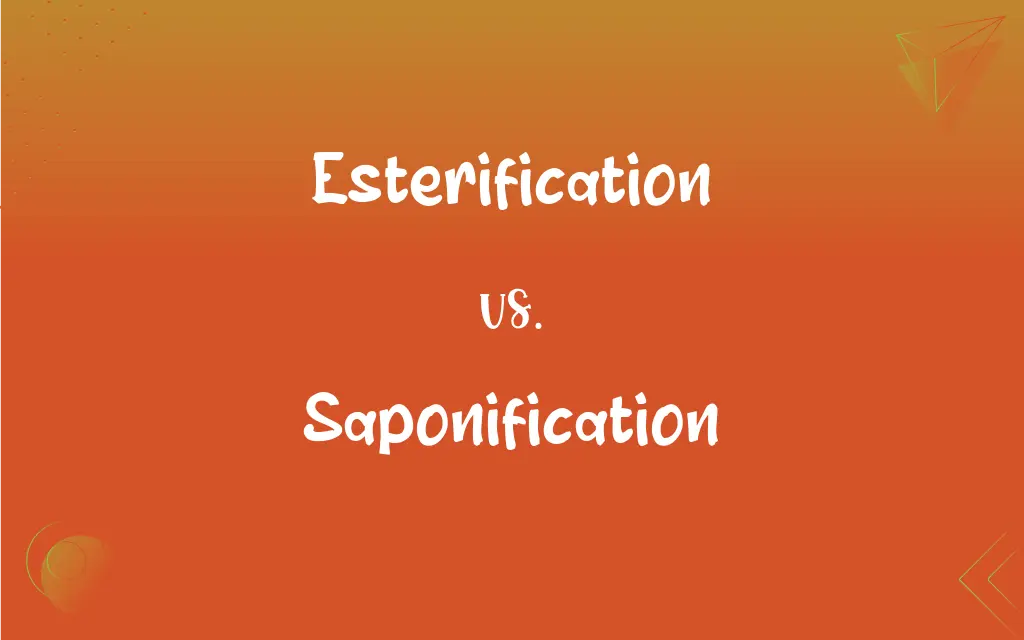Esterification vs. Saponification: What's the Difference?
Edited by Aimie Carlson || By Harlon Moss || Updated on October 23, 2023
Esterification is the reaction forming an ester; saponification breaks down esters, producing soap and glycerol.

Key Differences
Esterification is a chemical reaction in which an acid (often an organic acid) reacts with an alcohol to form an ester and water. Saponification, on the other hand, is the hydrolysis of an ester, typically a fat or oil, in the presence of a base to produce soap and glycerol.
The primary purpose of esterification is to produce esters, which are compounds commonly used in fragrances, flavors, and many organic syntheses. Saponification is mainly utilized for soap production, taking advantage of the fact that fats and oils are esters of fatty acids.
The catalyst for esterification is typically an acid, facilitating the reaction between the alcohol and the acid. In contrast, saponification involves a base like sodium hydroxide or potassium hydroxide, which drives the hydrolysis of the ester bond.
Esterification is an equilibrium reaction, meaning that it doesn't go to completion, and the reaction mixture typically contains unreacted acid, alcohol, and water, along with the ester. Saponification is more or less a one-way reaction, with the ester being completely converted into soap and glycerol under the right conditions.
In simple terms, while esterification creates esters, saponification breaks them down. Both processes are integral to various industries, with esterification being crucial in the production of plastics and resins, and saponification being central to the soap-making industry.
ADVERTISEMENT
Comparison Chart
Reaction Type
Synthesis
Hydrolysis
Main Products
Esters
Soap and Glycerol
Reactants
Acid and Alcohol
Ester (usually fat/oil) and Base
Catalyst
Acid (e.g., sulfuric acid)
Base (e.g., sodium hydroxide)
Industrial Use
Production of fragrances, flavors, plastics, and resins
Soap production
ADVERTISEMENT
Esterification and Saponification Definitions
Esterification
The chemical process of forming an ester from an acid and an alcohol.
Esterification of acetic acid with methanol produces methyl acetate.
Saponification
A method utilizing strong bases like sodium or potassium hydroxide.
Saponification with potassium hydroxide yields a softer, often liquid soap.
Esterification
A reaction that results in the combination of acid and alcohol molecules.
Esterification can be reversed with the presence of water.
Saponification
The hydrolysis of an ester in the presence of a basic catalyst.
Saponification values help determine the molecular weight of certain esters.
Esterification
A process that releases water as a byproduct.
In the esterification of propanol and ethanoic acid, water is one of the products.
Saponification
The process of making soap by breaking down fats or oils with a base.
Saponification of olive oil with lye produces olive oil soap.
Esterification
The synthesis method for producing esters used in fragrances and flavors.
Many fragrances are created through the esterification of specific acids and alcohols.
Saponification
A reaction converting esters into alcohol and salt of the acid.
Traditional soap-making uses the saponification of animal fats.
Esterification
An equilibrium reaction between carboxylic acids and alcohols.
During esterification, both the forward and reverse reactions occur simultaneously.
Saponification
The breakdown mechanism for esters, producing glycerol and salts.
In the saponification of triglycerides, glycerol and fatty acid salts are the main products.
Esterification
A chemical reaction resulting in the formation of at least one ester product.
Saponification
A reaction in which an ester is heated with an alkali, such as sodium hydroxide, producing a free alcohol and a carboxylate salt, especially alkaline hydrolysis of a fat or oil to make soap.
Esterification
(organic chemistry) Any reaction (typically between an acid and an alcohol) that results in the production of an ester
[http://www.sigmaaldrich.com/etc/medialib/docs/Aldrich/Acta/al_acta_30_01.pdf Aldrichimica Acta Volume 30 No 4] (pdf) from [http://www.sigmaaldrich.com/chemistry/chemical-synthesis/learning-center/aldrichimica-acta.html Sigma-Aldrich]
FAQs
What's the significance of saponification in daily life?
Saponification is the foundational process in soap-making, whereas esterification often produces fragrances.
Is water always produced in esterification?
Yes, water is a byproduct of esterification, while it's a reactant in saponification.
Are esterification and saponification opposite reactions?
Essentially, yes. Esterification creates esters, and saponification breaks them down.
Which base is commonly used in saponification?
Sodium hydroxide or potassium hydroxide are commonly used in saponification, while esterification typically uses acid catalysts.
Is saponification a type of hydrolysis?
Yes, saponification is a specific kind of hydrolysis where esters are broken down in the presence of a base. Esterification is a dehydration synthesis reaction.
How does the presence of water influence esterification?
Water can reverse esterification, pushing the reaction backward. In saponification, water is essential for the hydrolysis of the ester.
Can esterification be reversed?
Yes, esterification is reversible, often by hydrolysis, while saponification is the hydrolysis of esters.
Can esterification be used to produce biodiesel?
Yes, transesterification, a type of esterification, can produce biodiesel. Saponification doesn't have a direct role in biodiesel production but relates to the feedstock (fats/oils) used.
Is soap the only product of saponification?
No, saponification produces soap (salt of fatty acids) and glycerol. Esterification produces esters and water.
Can saponification be used to determine the nature of unknown fats?
Yes, saponification values can help characterize fats or oils. Esterification reactions, on the other hand, don't typically serve this purpose.
What's the main product of esterification?
The primary product of esterification is an ester, while saponification produces soap.
Can saponification occur in acidic conditions?
No, saponification requires basic conditions. In contrast, esterification usually occurs under acidic conditions.
What happens if saponification is done using a strong acid?
Using a strong acid would not lead to saponification but rather hydrolyze the ester into its acid and alcohol components. Esterification can then occur between these products under the right conditions.
How can the rate of esterification be increased?
Esterification rate can be increased using catalysts, removing water, or increasing reactant concentrations; saponification rates are influenced by the type of ester and base used.
Why is glycerol produced in saponification?
Glycerol is produced in saponification because fats and oils are triglycerides, which have a glycerol backbone. Esterification, on the other hand, doesn't necessarily involve triglycerides.
What are the applications of esters in daily life?
Esters, produced by esterification, are used in fragrances, flavors, and some solvents. Saponification mainly finds its application in soap-making.
Is the saponification number important?
Yes, the saponification number indicates the average molecular weight of the triglycerides in a fat or oil. Esterification doesn't have a direct equivalent to this measurement.
Do both reactions occur at room temperature?
Esterification can occur at room temperature but is often heated to drive the reaction. Saponification rates are enhanced with heat, especially for solid fats.
Can all esters undergo saponification?
Most esters, especially triglycerides in fats and oils, can undergo saponification, while esterification primarily forms these esters.
What type of ester is typically produced in labs for experiments?
Ethyl acetate, formed by esterification of acetic acid and ethanol, is a commonly produced ester in labs. Saponification in labs often uses simpler esters to demonstrate the reaction.
About Author
Written by
Harlon MossHarlon is a seasoned quality moderator and accomplished content writer for Difference Wiki. An alumnus of the prestigious University of California, he earned his degree in Computer Science. Leveraging his academic background, Harlon brings a meticulous and informed perspective to his work, ensuring content accuracy and excellence.
Edited by
Aimie CarlsonAimie Carlson, holding a master's degree in English literature, is a fervent English language enthusiast. She lends her writing talents to Difference Wiki, a prominent website that specializes in comparisons, offering readers insightful analyses that both captivate and inform.































































